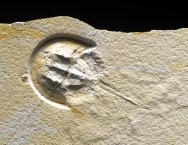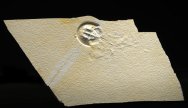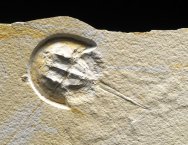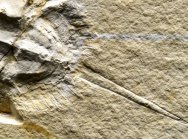Mesolimulus walchi
Phylum Arthropoda, Subphylum Chelicerata, Class Xiphosura
Geological Time: Jurassic
Size (25.4 mm = 1 inch): Fossil is 135 mm in length by 65 mm in width ( 5 1/8 X 2 ¾”) on a large 60 x 33 cm (23½ x 13”) plate
Fossil Site: Solnhofen Limestone, "Plattenkalk” Malm Zeta 2, Eichstatt, Germany
Fossil Code: PFO174
Price: $975.00
Description: A top German curator has masterfully prepared this exceptional specimen. Because of a lack of natural color, skillful etching has been done around the edges of the body parts of the Mesolimulus to enhance it’s presence. To repeat, there has been no color enhancement of this specimen. It has a natural faulted crack and several smaller fractures that have been repaired. Because of the rarity of discovery, and a strong German demand for fine Solnhofen fossils, Mesolimulus are seldom available to U.S. collectors. Xiphosura, the horseshoe crabs, are related to the extinct Eurypterids, and more distantly to spiders and scorpions. Their lineage traces back to the Cambrian, and extends to modern times as the genus Limulus. This fossil is of a similar genus known as Mesolimulus from the Solnhofen lithographic limestone deposits of Eichstatt, Germany. The 150 million year old lagerstätte deposits of Solnhofen are famous for their exceptionally well-preserved organisms, the most famous of which are the handful of specimens of the ancient bird Archaeopteryx. While there are only three extant genera and five extant species of Class Xiphosura, they were quite diverse during the Palaeozoic Era. Because they have apparently undergone little change, the extant horseshoe crabs are often considered to be living fossils. Horse shoe crabs have a large shield that covers the cephalothorax, and the carapace is hinged between the cephalothorax and abdomen. The sturdy exoskeleton comprises three parts, the large semicircular cephalothorax, the opisthosoma which is the posterior portion of body behind the cephalothorax, and a long tail spine or telson. The resemblance to trilobites is apparent, and, in fact, the Xiphosura are considered by many to be the closest living relatives of the long-extinct trilobites. Also see: Solnhofen Fossils |



